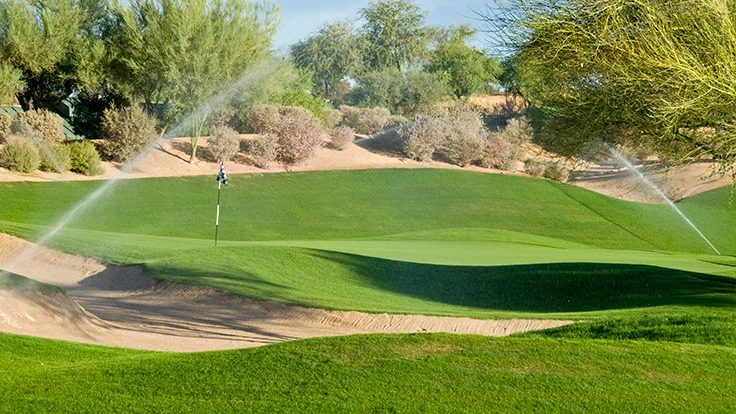
 There are multiple avenues of nutrient loss brought on by excessive irrigation and rainfall. Fertilizers can move offsite, either running off into surface waters or leaching below the soil. Excessive runoff of key nutrients can raise environmental concerns, says Dr. Larry Murphy, owner of Murphy Agro and consultant for Compass Minerals. At the same time, nutrient loss halts the plant’s positive response to the application and superintendents lose out on money. “Getting a good fertility program established and maintaining that throughout the year and into the fall is important in retaining nutrients against leaching or runoff,” Murphy says.
There are multiple avenues of nutrient loss brought on by excessive irrigation and rainfall. Fertilizers can move offsite, either running off into surface waters or leaching below the soil. Excessive runoff of key nutrients can raise environmental concerns, says Dr. Larry Murphy, owner of Murphy Agro and consultant for Compass Minerals. At the same time, nutrient loss halts the plant’s positive response to the application and superintendents lose out on money. “Getting a good fertility program established and maintaining that throughout the year and into the fall is important in retaining nutrients against leaching or runoff,” Murphy says.
Research shows that root systems of grasses remain relatively active after a single frost, but they lose most of their aggression, says Dr. Michael Goatley, professor and extension turfgrass specialist at Virginia Tech. “They remain active throughout the winter, but at a very reduced rate during the coldest parts,” he says. Superintendents should adhere to soil tests and apply nutrients before the first killing frost. If they are using slow-release fertilizers, they need to water them in prior to blowing out their irrigation system.
When watering in slow-release fertilizers, superintendents needs to know the depth of their rootzones because if they push fertilizers too far into the profile, those fertilizers will leach, Goatley says. With the exception of flushing salts and other materials through the profile, superintendents should only irrigate to the depth of the root system. “I think it is somewhat situation-dependent and even putting green-dependent on sand-based putting greens to understand, ‘Where are my roots?’” he says. “Pull some cores, get a feel for how far that moisture front is moving down and think about, ‘Where is that fertilizer at if I push it down here?’ because you don’t want to move all that stuff through your sand-based system.”
Periodic flushing of greens can have its benefits, but it needs to be matched with an understanding of where nutrients are and if turf is still responding to them, Goatley says. Potassium levels are particularly difficult to visualize because of the often lack of color change or insignificance of a clipping response, but that doesn’t mean the nutrient isn’t there. “That’s one of those cases where on sandy soils you’d like to have soil samples being done at least on an annual basis to see where you are,” he says.
In addition to leaching, nutrient runoff is a potential concern for superintendents making fall fertilizer applications. Numerous states have passed legislation that limits phosphorus use because of runoff and concerns relating to algal blooms, fish kills and other water quality concerns, says Dr. Cale Bigelow, professor of agronomy at Purdue University. Much of the legislation states that phosphorus can only be used if soil tests indicate a need for it. “You look at the whole Chesapeake Bay area, and you look at New Jersey, you look at Minnesota and Michigan, Wisconsin—they all have something in place,” he says.
Superintendents can limit runoff and the environmental issues associated with it by using slow-release and foliar fertilizers and avoiding the application of fertilizers in close proximity to water, says Joey Young, assistant professor of turfgrass in Texas Tech University’s Department of Plant and Soil Science. “If we’re applying fertilizers to areas that have healthy and actively growing turf, then that’s going to limit, by a long stretch, the potential for runoff,” he says. If superintendents keep fertilizers a safe distance away from a water source — approximately 10 to 15 feet — the odds of the fertilizer running off into surface waters is diminished.
Although they each impact the turf in their own way, both granular and foliar fertilizers can effectively work to prevent leaching and runoff, Young says. “The foliar options, the slow-release options, those are all going to be beneficial to help limit some of that movement either way — through the soil or on top,” he says.
Patrick Williams is a GCI contributing editor.
Latest from Golf Course Industry
- From the publisher’s pen: Conscientious of a bigger role
- Bernhard and Company partners with Laguna Golf Phuket
- Terre Blanche showcases environmental stewardship
- VIDEO: Introducing our December issue
- Bernhard and Company introduces Soil Scout
- Nu-Pipe donates to GCSAA Foundation’s Centennial Campaign
- GCSAA enhances golf course BMP tool
- Melrose leadership programs sending 18 to 2026 GCSAA Conference and Trade Show





